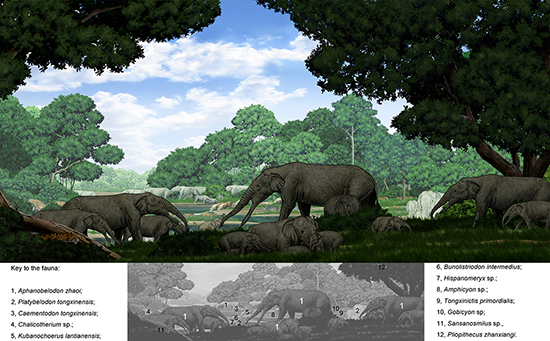| Location: Home > Research > Research Progress |
| A weird combination of Deinotherium and Platybelodon- Elephantiformes without ivories, which were discovered by IVPP |
|
In the main Proboscidean taxon of Elephantiformes, a huge pair of developed top incisors (ivories) has become a distinctive feature of this taxon. The structure is usually made as a tool for individual foraging and a weapon for males to compete for mating. The Proboscidean taxon without ivories usually and only exists in the primitive taxon that were differentiated before Oligocene, for instance, Deinotherium merely developed a pair of hooked lower incisors and its top incisors were totally missed. In the early revolving period of Elephantiformes, a group termed as Amebelodontidae appeared, whose lower jaw and lower incisor are elongated and widened specially to form a shovel-shaped structure. The researchers were always interested in the weird evolution direction. Many hypotheses and studies have been made about the functional and morphologic significances of shovel-shaped lower jaws in Amebelodontidae. Recently, Researchers, Shiqi Wang, Tao Deng and Jie Ye, in IVPP, together with collaborators in Hezheng Palaeozoological Museum, Gansu, have found the conserved delicate Amebelodontidae fossil group in Middle Miocene in Dingjiaergou, Tongxin, Ningxia and published it on Journal of Systematic Palaeontology online. The fossil group is representative of 11 quite intact individuals with different sexes and ages, having the shovel-shaped lower jaw and lower incisors and undoubtedly belonging to the Amebelodontidae. However, the feature of missed ivories irrespective of the sex and age period was firstly found in the Elephantiformes. The new group is named as Aphanobelodon zhaoi gen. et sp. nov. The genus name, “Aphanobelodon” indicates its main feature of ivory missing; and its species name is contributed to Mr. ZhaoRong, the discover of the fossil group. The critical significance of discovering the Aphanobelodon zhaoi lies in revealing the diversified morphological and ecological differentiation of Elephantiformes during the early evolution. The studies and verification of branching system showed that Aphanobelodon zhaoi existed as the sister group of Platybelodon in the systematic evolution. However, the internal structure of its lower incisor is very different from the Platybelodon, but similar to the other Protanancus in the Amebelodontidae. So, the same structure of lower incisors is not made as a distinguishing criterion for inner members of Amebelodontidae, but it is a parallel evolution under the selection pressure. Studies by microwear and mechanics analyses maintained that the group representated by Aphanobelodon zhaoi and Platybelodon in Amebelodontidae were specialized into a group that fed on the tender leaves and its wide-shovel-shaped lower jaw was mainly used to cut the tender shoots and leaves; and the other group represented by Protanancus had a broad spectrum of food, had a narrow-shovel-shaped lower jaw used to dig the shallow-layer underground plants whilst its ivories played an important role in foraging. The inner systematic differentiation of Amebelodontidae represents the ecological differentiation as well. The top incisor missing in the male Aphanobelodon zhaoi suggests that the fights between males might be not fierce. Therefore, the social structure of Aphanobelodon zhaoi is supposed to be different from other elephants. Perhaps, the males and females in Aphanobelodon zhaoi composed a stable breeding colony and co-nursed the minor offspring. This is vastly different from the matriarchal society that forms a large scale of colony by females to nurture the offspring in the existing elephants.
Figure 1. Selected individuals of the fossil accumulation of Aphanobelodon zhaoi gen. et sp. nov. showing the age-sex structure.
Figure 2. Habitat reconstruction of Aphanobelodon zhaoi gen. et sp. nov. of the Dingjiaergou Fauna during the early Middle Miocene, by Yu Chen. |

